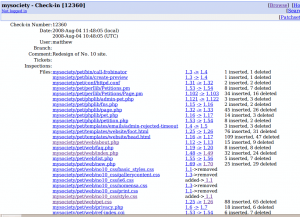Number 10: The same thing twice?
I’m not quite sure I fully grasp what is going on with this (some would say I never do) but maybe it might be of interest to other readers and hopefully someone will come along and explain a bit more.
I was looking about on-line the other day just following my (rather large) nose around the ‘Anthony Baggett’s theme being used by Number 10 Downing Street’ story. And I came across something I don’t really understand. Perhaps others might be able to shed some light on what might be going on here?
Let’s start with the background: Number 10’s Website, is using a look and feel derived from an original theme by Anthony called NetWorker. The way we know this is by the header that was left in the main stylesheet and almost every other file from Anthony’s original package being left in tact on the server.
During my wanderings around the internet I came upon this page: https://secure.mysociety.org/cvstrac/chngview?cn=12360 which shows a list of files that have been updated or changed in some way on a developer’s version control system called CVS. The owner of this system is a group called MySociety.org.
According to their website, MySociety are a non-profit charity and who look to have built some pretty interesting sites; many around freedom of information and enabling better access to Government. They were responsible for creating the Petitions System for Number 10 which looks to have been written as a custom application using at least Perl and PHP.
Here is a screenshot of the page showing the date of the commit (04/08/2008) and the name of the committer (matthew) and a quite long list of files that have been added, removed or altered as part of this commit.
For those who are not familiar, this kind of tool is used by developers to manage software projects. You can literally see each change made to your project, by time and by developer so when something gets fixed (or gets subsequently broken again) you can go back in time and recover your project to the same state prior to a particular commit.
I would like to draw your attention toward the bottom of the page in the screenshot. There you can see a few stylesheet files being removed and two new ones being added. One line in particular caught my attention:
“mysociety/pet/web/no10_css/style.css added-> 1.1“
If you click on the revision number (1.1 in this case) to view the contents of the file1 you will see that the it has the same header as that of the main Number 10 Downing Street file.
I used the Meld comparison tool as I did before to compare it with Anthony’s original2, and this is another derivative work of Anthony’s original style.css file. And I compared this one with the stylesheet used for the main Number 10 website3 they are very, very similar indeed.
If you visit the Prime Minister’s petition site note the similar look and feel to the main 10 Downing Street pages. Now take a look at the stylesheet for this site: http://petitions.number10.gov.uk/no10_css/style.css.
This looks to me like two separate websites, developed by two different companies, but both using the same derived work. Anyone care to elucidate?
1. My Society’s stylesheet
2. Anthony’s original stylesheet
3. No. 10’s heavily modified stylesheet
Number 10, WordPress and The Commons
This is a post largely related to the response that David Smith of New Media Maze posted yesterday regarding the farce of their web site development for Number 10 Downing Street.
The story so far, for any new readers, can be found here, here and here. And do follow the links in those posts to the various other sources to get a broader picture.
(David, if I am wrong anywhere, I assume you will let me know…)
What concerns me greatly about this whole fiasco is that New Media Maze are still (as I write this at least) basically trying to act as though they’ve done nothing really wrong and everything is fine. I think it isn’t.
David’s post seems to be an attempt to convince the reader that because they changed lots of things from the original template, their requirement to appropriately attribute the original work is negligible and the lines they forgot to remove left in the stylesheet are sufficient.
His post also, to me at least, indicates a rather poor appreciation of what Open Source, “The Commons” and the new collaborative world in which we all live really mean.
First then, the WordPress theme.
The simple fact is this: the Number 10 website which New Media Maze claim to have designed is based on original work by somebody else. How much of the original work remains in the design is really not important, although almost all of the original stylesheet is still present within the gargantuan ~4000 lines of the new site’s file. (Incidentally, who on earth designed a stylesheet like that? I don’t recall ever seeing a 65kb stylesheet before. Maintenance and alterations are going to be fun…). And we also saw that the index.php file was from the original source as they had left the comment in it.
Irrespective of the legal position New Media Maze believe themselves to be in, the right (as in decent, proper, common) practice in these circumstances is to attribute the work in a suitable manner. Such as a simple line somewhere on the site saying something like: “This website is based on an original idea by…”.
I’m sure you all get the idea. And being a “Full Service New Media Agency” I’m sure NMM could come up with something suitably profound.
Most people on the Internet have no idea what a CSS is, how to find or read one, and why should they to be frank? There was a visible copyright notice in the original theme. It has been removed.
The continuation of this farce, by NMM is not helping their position, or their client’s, one little bit. To be honest, by continuing to bleat on about how little of the original work was used rather than just doing the right thing, makes them look like [insert your prefered derogatory phrase here]. My personal choice would be “a bunch of cowboys”.
On a secondary, but related note, an impression I get from reading David’s statement makes me wonder if Downing Street are actually running WordPress or are in fact running some uberpress code that has been made ultra-secure and “top secret”. If I am wrong about this please let me know, it is just an assumption on my behalf. What version of WP are they running? We can’t tell as they took out the meta-tag.
If they have hacked the code to make it more secure, I hope that those modifications have been provided back to the WordPress community so everyone gets the benefit. If they haven’t, Downing Street are not running WordPress, but a fork. They are now stuck with a version which will get harder and harder to maintain, and will ultimately be less secure than the publicly developed OSS code that has the world’s eyes watching and improving it every day…. I hope I am wrong and the backend is a regular WordPress release but if it isn’t, then Downing Street really have been sold a pup and are not using Open Source code at all.
And you want ID Cards??? (More on Number 10)
This is quite amazing stuff really. You just couldn’t make up a better story.
The Number 10 website fiasco just keeps going.
New Media Maze, that “Full Service New Media Agency”, look to have really screwed up. Not only have they nicked a free WordPress template and removed the attribution and removed the license, but it seems the site itself is actually full of bugs and errors too.
Dizzy Thinks has found some lovely errors and a strange chap called “Adam Test”… ROTFL.
And when you’ve finished rolling around on the floor laughing take a look at this research on The Rouseabout to see what a little more digging throws up: (I’ll give you a clue: 404s).
Honestly, if this is what we get for £100,000 of taxpayer’s money from New Media Maze then, quite frankly, I’m glad I hadn’t heard of them before.
How much are the Gov. going to spend on our ID card database? The one that nobody wants. Do you trust them to get it right? Nahhh.
And Glyn Moody discovered a little known government project to build a “massive central silo for all UK communications data…”.
It’s at times like these that I fall on my virtual knees and bless the cyber-gods that ensure every single major UK government project is a complete and utter failure, so this doesn’t stand a snowball’s chance in hell of ever working properly. Phew.
PLEASE!!!! Someone take these huge IT projects out of the Government’s hands! They are so crap at it our whole lives will end up on Facebook if we aren’t careful… Oh, most already are.
All we need now is for Microshaft to come rolling along spouting off about how much better the site would have been if they’d spent the money on Blog Server 2008 running on Windoors 2010 with Sequal Server 2012… or whatever crap it is they are pushing this week.
More on Number 10’s website fiasco
Being “that-kind-of-a-bloke”, I thought I’d dig a bit further into the Number 10 Steals Free WordPress Theme story 😉
Here’s the background:
- No. 10 Are running WordPress1
- The theme (or template) is based on one called NetWorker2
- The attribution and copyright notice that is in the original footer has been removed
- The site claims to be Crown Copyright and makes no reference to the CC-by-sa license used in the original template
I am a bit confused here. Why would a web design shop (or “Full Service New Media Agency” as they call themselves), who were apparently paid the best part of £100k for this job3, use somebody else’s template as the basis for their design?
- You might think it would be because using a pre-made template would save you loads of tricky coding and playing around with CSS trying to get your site to look the same in IE6, IE7, Firefox, Safari and Opera [A task I am quite familiar with myself].
- You might also think that using a pre-made template would allow you to make minor modifications, add some different images and give you something that looks really different.
- Of course it might be simply that you don’t have time to create a new theme from scratch and using an “off-the-shelf” template will mean you can get the site up and running much faster.
- Or another possibility could be that you like ripping off your customers for as much as possible and using a free (or even a bought) template will mean your costs are minimal.
All, some, or none of the above could be reasons to use an existing template as a basis for your new design.
So how much new coding would be needed making the changes to an existing template to suit your new design? 10%, 20%, maybe even 50% and it would still be worth while…
Get this: the revised stylesheet from Anthony Baggett’s template is more than 6 times the original’s length and size! And that isn’t all made up of whitespace either…
The original stylesheet4 is 612 lines in length and is 9234 bytes in size (9KB).
The modified stylesheet5 is 3826 lines long and weighs in at a frankly astonishing 63724 bytes (63KB)!
You can obviously download the two stylesheets from their websites directly (I recommend using a plugin for Firefox called Web Developer) or to make things easier, I have made them available at the bottom of this page.
Looking through the new file, the amount of duplication and repetition of styling of the same, or very similar elements, is quite odd. It certainly isn’t the way I would construct a theme. Why duplicate the same styling over, and over, and over again when you could craft the logic so that each of these elements have a commonality that could then be controlled with a much smaller stylesheet?
Here are a few screenshots showing some of the differences between the two files. In the brilliant Open Source comparison application Meld I’m using here, the original stylesheet is shown in the left pane and the modified one is on the right. The first image shows the very top of both files with Anthony’s header still in tact. The second and third are just a couple of fairly random points where the new file contains a great deal of repetition as I am walking down through the files. The final image shows the bottom of both files (note the line numbers!).
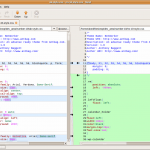
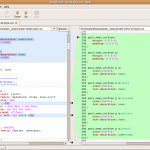
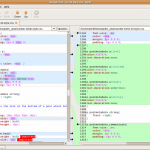
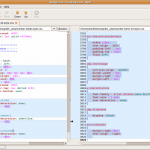
One thing that is clear from using a tool like Meld is that these two files are definitely related. The way the application displays the differences, it is clear where the files are the same and where they differ. The larger file is certainly a derivative work of Anthony’s original.
Another aspect I found rather funny in this investigation was the method of version control for this huge stylesheet. Both stylesheets have the same version number and there doesn’t appear to have been any tool used to update the header as would be usual. How on earth does a business that develops a ~4000 line stylesheet manage to do that without using some sort of versioning system?
I have helped businesses use and modify pre-made templates for Joomla!, and to be honest if you are making changes of any significance to these templates, it is almost always easier and quicker and cheaper to start from scratch. For small mods and changes pre-bought templates can be really good value (I mean $50 is fairly average), but getting your head around someone else’s code is never easy and takes considerable time. For major alterations it just doesn’t make financial sense.
Now, making additions and changes just to the stylesheet of more than 6 times the original is not good business sense in my opinion. How much more work have they done to the PHP code that we can’t see? We know they have modified at least index.php (by removing the WordPress statistic generator meta tag) and footer.php (by removing Anthony’s copyright notice). But if they have made SO MANY changes and additions to the stylesheet, there surely must be a good deal of altered php code, or additions, in the core php files too? Surely, it would have been easier to make a new template from scratch in this instance?
This leads on to the other question that might be worth digging into a bit more; GPL violations:
“If” the developers have modified the WordPress engine, as is being suggested as a possibility here, and then sold it to the Government, in my humble understanding that means they have distributed their modifications. That means those modifications must also be licensed under the GPL. I had a quick look on New Media Maze’s web site and couldn’t find an area for software downloads or mention of the GPL. That doesn’t say anything to be honest and there might be nothing to this, but it would be interesting to find out a bit more… Is there a real WordPress guru who can look at the “footprint” of the XHTML the site generates and tell if it is different? Or are there any other ways to tell if it has been modified?
Anyway, what a wheez this all is for us bloggers: It just isn’t Gordon’s year is it…
1. www.number10.gov.uk/
2. NetWorker Theme
3. £100k for WordPress site
4. Anthony’s original stylesheet
5. No. 10’s heavily modified stylesheet
Number 10 and the Creative Commons
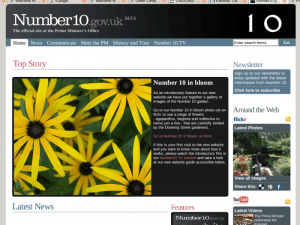
Number 10’s new website, from our beloved government who are such strong users and supporters of Open Source Software [NOT], is running on WordPress. This isn’t actually big news now. There’s plenty of comment about that on the web via Google.
Well, that’s OK I guess. At last they are starting to grok OSS perhaps, although I’m rather inclined to actually surmise that they [#10] don’t even know what WordPress is. They just bought a website…
Anyway, quite a nice site layout don’t you think? I wonder who designed their site?
Looking at the html source, we see that the stylesheets are in a directory called networker-10/ and many of the images are in a subdirectory called images/.
Firstly, see the bit above where it says ? Usually, in there, that line reads: where the X.X.X is the version of WordPress the site is running.
So they’ve removed changed that then. I wonder if they are trying to conceal the fact they are using WP? Not a very useful trick though is it? Having a directory tree called /wp-content/themes/... is a bit of a giveaway if you ask me.
Now then, if you visit Antbag.com and look at some of the themes they have created, there’s one on there called “Networker”. Here’s the demo page http://antbag.com/demo/index.php?wptheme=NetWorker
Let’s look at the top few lines of the html source for this theme:
They look quite similar don’t they? The directory structure is identical and the top-level theme directory is called networker-10. Amazing…
The Networker theme is licensed under a Creative Commons Attribution-ShareAlike 3.0 License. Which you can read all about here: http://creativecommons.org/licenses/by-sa/3.0/
I can only assume that Number 10 have requested, and received, permission of the author to remove all traces of this license and attribution from their WordPress site. I have left a “contact us message” at the author’s website to see if this is the case…
[Update] Anthony Baggett, the theme’s author, has just confirmed that No 10 have not requested that the attribution be removed. That’s not playing fair by my book.
[Update 2] Seems like I am not the only one to have noticed this. A bit more digging has thrown up the following sites also commenting on #10’s cock-up. One is also suggesting it cost £100k. Not bad for a ripped off theme running on an Open Source blogging engine… Links below]
http://cabalamat.wordpress.com/2008/08/16/prime-ministers-website-breaks-copyright-law/
http://community.livejournal.com/theyorkshergob/123043.html
http://www.mikerouse.net/2008/08/15/10-downing-street-wordpress-website-knock-off-and-rip-off/
http://dizzythinks.net/2008/08/downing-street-claims-crown-copyright.html
